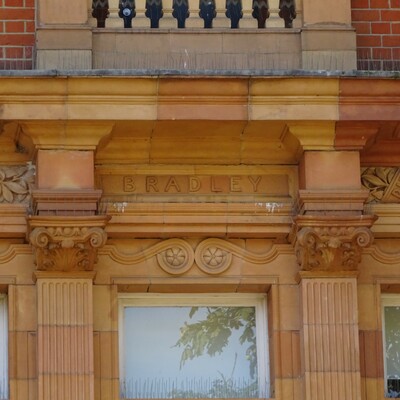Astronomer. Born Sherborne, Gloucestershire. Elected as the Savilian Professor of Astronomy at Oxford 1721-62, his death. In 1742 he was appointed Astronomer Royal. He is best known for two fundamental discoveries in astronomy: the aberration of starlight (the first proof that the Earth revolves around the Sun - 1728), and the nutation of the Earth's axis (the periodic variation in the inclination of the Earth's axis - 1748).
Bradley moved from Sherborne to Wanstead in 1711. He graduated from Oxford University, MA in 1717 and was ordained into the church. In Wanstead he lived with his maternal uncle, James Pound, who was a rector of St Brides in Overton Drive. This was before the medieval church was replaced, 70 foot to the north, by the present building, St Marys, 1790.
Bradley and Pound lived at the rectory ( have a 1905 postcard image) which was demolished c.1924 and replaced with Wanstead county high school in Redbridge Lane West. Contrary to reports on the web, Bradley did not work as Pound’s curate. Pound was one of England's leading astronomical observers and undertook observations on behalf of Isaac Newton. Bradley shared in this work with him. They made many astronomical observations near the rectory.
Pound's wife Elizabeth (m.1722), and her brother, Matthew Wymondesold, were both very wealthy. Matthew lived on his extensive estate, Wanstead Grove, which was to the east of the High Street, the house being at what is now the junction of Grove Park and The Avenue. Pound died suddenly, 16 November 1724, and his widow Elizabeth went to live with Matthew and his family, as did Bradley. Pound had died intestate, leaving Bradley financially dependent on Elizabeth. Bradley and Elizabeth lived together until her death in 1740, both in Wanstead and in Oxford. Marriage between aunt and nephew was no more legal then than it is now.
Elizabeth owned a small townhouse in the village, located more or less where the present Co-op is, 87 High Street. Neither Elizabeth nor Bradley ever lived in this house but this is where Bradley carried out his research and made his two important astronomical discoveries (aberration and nutation) 1728 - 48.
We are grateful to Dr John Fisher for helping us understand the story of Bradley in Wanstead. He considers Bradley to be "the most important astronomer in Europe in the eighteenth century" and is the author of 'The life and work of James Bradley : the new foundations of 18th century astronomy', Oxford University Press (2023). We are very grateful to John for his time and patience. Prior to speaking to him we were puzzled by the location of the plaque, since the information we'd found led us to think that all of Bradley's experiments were carried out near the church and/or the rectory.
relates that in 1717 Isaac Newton purchased a maypole which had stood at St Mary Le Strand, and had it delivered to Pound and Bradley who used it to build a telescope. (See St Mary Axe/Leadenhall for more information on London maypoles.) John writes: “The transportation of the lengthy maypole from the Strand to its location close to the rectory must have been quite a spectacle. Amusingly Pound paid the workmen 17 shillings to put the maypole up and 40 shillings on beer for the men. I hope a good time was had by all.”
The has a drawing of a telescope Bradley commissioned in 1727 for use in Wanstead.
One puzzle remains. John is in no doubt about the location of the rectory, but rectories are usually much closer to their church, often next door, so to us it seems odd that that this one was so far away. Our doubts were only strengthened when we saw the which, indeed, shows the "Rectory" in Redbridge Lane, but also labels the church as "St Mary's Church (Rectory)". Apart from the church and the stables, no significant buildings are drawn near that label, but perhaps by this time the rectory had been demolished, which would explain the brackets. Is it possible that the new church was built on the site of the old Rectory? Someone with knowledge of Wanstead church history can probably resolve this issue.
Other sources include: , , , , .








Comments are provided by Facebook, please ensure you are signed in to see them